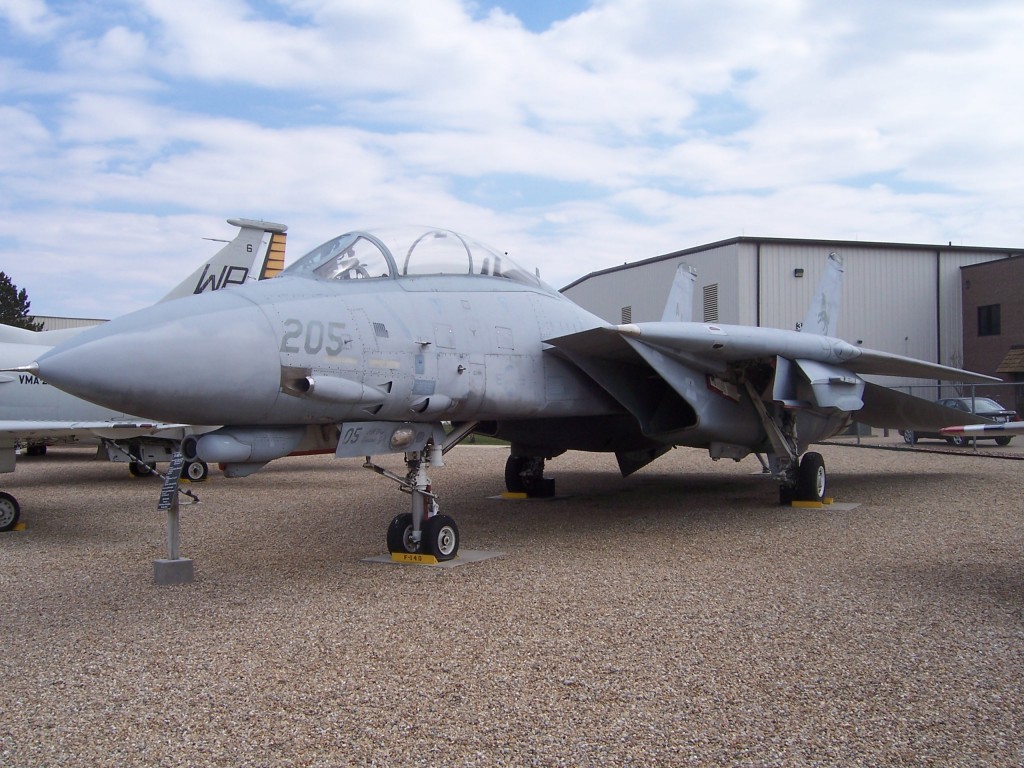


Prairie Aviation Museum recieved this F-14D Tomcat in April of 2006 from the US Navy. The final flight of this aircraft was to the Bloomington/Normal airport. People came from many states to witness the arrival of aircraft 205 from VF-213 Black Lions, for most it would be the last time they would see a F-14 in flight.
Grumman F-14D Tomcat
The Grumman F-14 Tomcat is a supersonic, twin-engine, two-seat, variable geometry wing aircraft.
During its active service in the United States Navy (1972-2006) the F-14 Tomcat was the Navy’s primary air superiority fighter and tactical reconnaissance platform.
It later performed precision bombing in close air support roles.
It was developed after the collapse of the F-111B project, and was the first of the American teen-series fighters which were designed incorporating the experience of air combat in Vietnam against Migs.
It entered service in 1972 with the Navy, replacing the F-4 Phantom II. It was later exported to the Imperial Iranian Air Force in 1976.
It was retired from the U.S. Navy fleet on 22 September 2006, having been replaced by the F/A-18E/F Super Hornet.
As of 2006, only the Islamic Republic of Iran Air Force still flies the aircraft.
The F-14 has completed its decommissioning from the U.S. Navy.
It was slated to remain in service through at least 2008, but all F-14A and F-14B airframes have already been retired, and the last two squadrons,
the VF-31 Tomcatters and the VF-213 Black Lions, both flying the “D” models, arrived for their last fly-in at Naval Air Station Oceana on March 10, 2006.
The last F-14 combat mission was completed on February 8, 2006, when a pair of Tomcats landed aboard the USS Theodore Roosevelt after one dropped a bomb in Iraq.
The plane was part of VF-31 and the last pilot credited with a bomb drop in combat was Lt. Bill Frank.
An F-14D from VF-213, the aircraft originally slated to come to Prairie Aviation Museum,
was the last F-14 to land on an aircraft carrier after a combat mission; it was piloted by Capt. William G. Sizemore.
During their final deployment with the USS Theodore Roosevelt, VF-31 and VF-213 collectively completed 1,163 combat sorties totaling 6,876 flight hours,
and dropped 9,500 pounds of ordnance during reconnaissance, surveillance, and close air support missions in support of Operation Iraqi Freedom.
On March 10, 2006, the 22 planes from these squadrons flew in formation into Naval Air Station Oceana, home from the last combat deployment of the F-14.
VF-213 pilots and radar interception officers who have made the transition to the Super Hornet continued F/A-18F (double seat) training as of April 2006.
The squadron is operational, or “safe for flight,” as of September 2006. VF-31 pilots who were making the transition began F/A-18E (single seat) training in October 2006.
VF-31 will be safe for flight in April 2007, making it the last official Tomcat squadron in the Navy.
The last flight of the F-14 Tomcat in US service took place October 4, 2006, with the final flight retirement ceremony on September 21, 2006.
Two F-14’s were readied for the ceremonial final flight; after the primary plane experiencing mechanical problems, a backup was flown instead.
The failure was a reminder of one of the reasons for the retirement, high maintenance costs.
The F-14 Tomcat was officially retired on September 22, 2006 at Naval Air Station Oceana.
The F-14 fleet is mothballed at the Davis-Monthan “Boneyard.”
2 (Pilot and Radar Intercept Officer)
2× General Electric F110-GE-400 afterburning turbofans, 13,810 lbs dry, 27,800 lbs with afterburner (72 kN / 126 kN) each
61 ft 9 in (18.6 m)
16 ft (4.8 m)
64 ft unswept, 38 ft swept (19m/11.4 m)
565 sq ft) (54.5 sq m)
NACA 64A209.65 mod root, 64A208.91 mod tip
Attack and close support helicopter
42,000 lbs (19,000 kg)
61,000 lbs (28,000 kg)
72,900 lb (32,805 kg)
Hughes AN/APG-71 radar
AN/ASN-130 INS,IRST, TCS
161163
7107.4
US $38 million
Mach 2.34, 1,544 mph at high altitude (2,485 km/h)
576 mi combat (927 km)
50,000+ ft (16,000+ m
45,000+ ft/min (230+ m/s
113.4 lb/sq ft (553.9 kg/sq m)
0.91)
1x M61 Vulcan 20 mm Gatling Gun
AIM-54 Phoenix
AIM-7 Sparrow, AIM-9 Sidewinder air-to-air
AIM-9 Sidewinder air-to-air
2x AIM-9 + 6x AIM-54
2x AIM-9 + 2x AIM-54 + 3x AIM-7
2x AIM-9 + 4x AIM-54 + 2x AIM-7
2x AIM-9 + 6x AIM-7
4x AIM-9 + 4x AIM-54
4x AIM-9 + 4x AIM-7
GBU-10, GBU-12
GBU-16, GBU-24
GBU-24E Paveway I/II/III LGB
GBU-31 GBU-38 JDAM
MK-20 Rockeye
MK Series Iron Bombs:
MK-82, MK-83, MK-84
| DATE | Duty stations |
|---|
|
|||||||||||||||||||||||||||
| Abbreviations used: | |||||||||||||||||||||||||||
|
|||||||||||||||||||||||||||